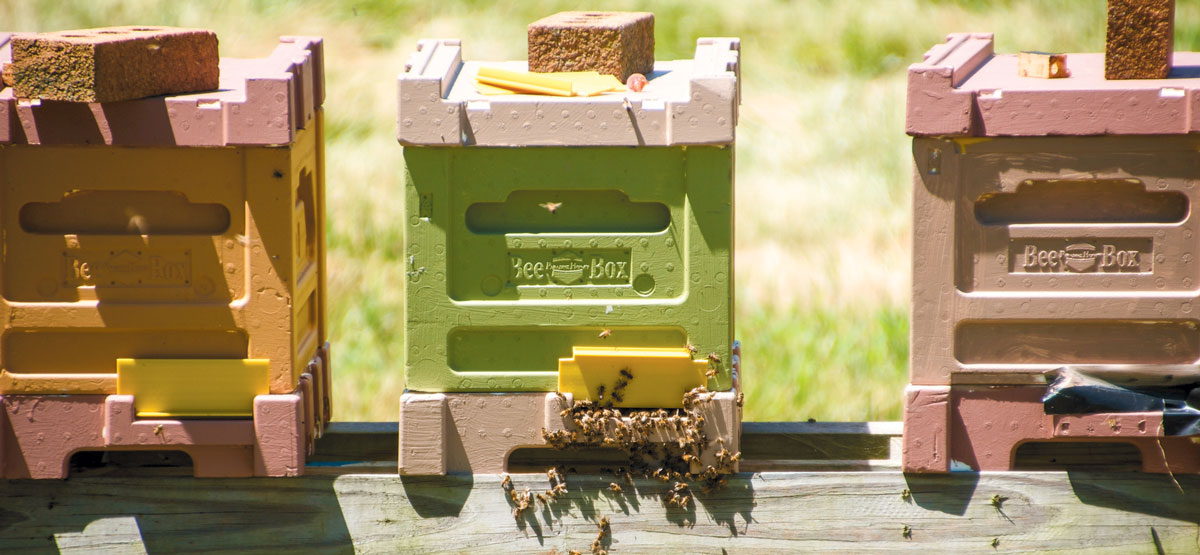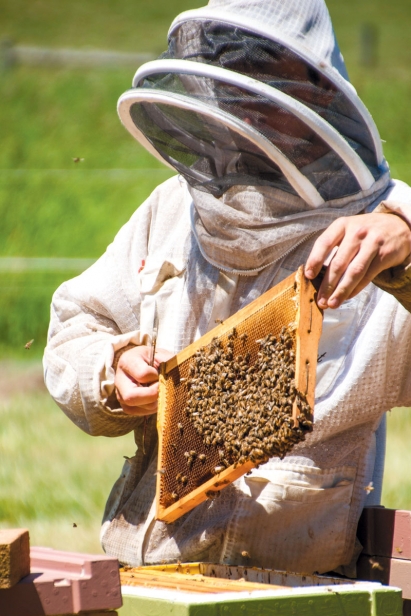Beekeepers Helping Beekeepers
An unlikely partnership between Dwight Wells and the Amish is revitalizing Ohio’s honeybee population
One of Ohio’s most critical populations is in crisis. Between April 2014 and 2015, the United States Department of Agriculture estimates that Ohio lost approximately 50% of its honeybee population. This loss not only dramatically reduces the number of bees available to pollinate crops; it represents the loss of 350 years of genetic resilience that serves to protect the bees from a number of environmental challenges.
Dwight Wells, founder of the West Central Ohio Honeybee Breeders Association, attributes this reduction to several causes. In 1970 Ohio dairy farmers were incentivized to give up dairy farming and instead produce corn and beans, using Roundup® Ready crops, crops that are resistant to herbicides containing glyphosate. Spraying glyphosate likely impacted local weeds and other flora that bees depend on for vital nutrition. In 1987 the varroa mite infected bees with a virus comparable to the human influenza virus and entered Ohio. And recently there has been a boom of well-intentioned amateur beekeepers, who lacked the proper training to sustain multi-year bee populations—something that can take up to five years, according to Dwight. The impact of these issues was magnified by the retirement of the only Ohio State University Extension educator specializing in beekeeping.
Dwight is working with researchers at several universities and other experts to improve the health of the queens and rebuild the gene pools to rebuild the bee population. One of these partners is Jim Kerns, bee inspector for Logan County.
Jim’s primary job is to open every hive in his county at least once a year to check the health of the queens and look for signs of disease. In addition to working to increase the ability of queens to mate, he says the process for treating the bee virus is complex, and it is common for entire hives to be lost in the process. While daunting, he credits Central Ohio’s progress to Dwight’s “incredible dedication” to mentoring and activism to increase beekeeping.
Although Dwight has been pulled away from his own beekeeping to work nationally and internationally to strengthen the queen bee population, he has become an unlikely link between academic researchers and the Amish community of Belle Center, Ohio, where beekeeping has taken hold as a valuable endeavor.
The relationship began in 2012, when at a meeting of the West Central Ohio Beekeepers Association in Springfield, Ohio, Dwight was surprised to see seven young Amish men arrive seeking information and support. They had recently become interested in beekeeping and wanted to learn from the experts. After three years of mentorship, Dwight is now a valued figure in the community, and together he and his apprentices have developed 300 new colonies and inseminated 10 new breeder queens.
The Amish are uniquely disposed to be successful beekeepers, Dwight explains. They come from a culture of respect for the land and already understand animal husbandry, or as he puts it, “for them, bees are just like cows, only smaller.” Because they also adopt apprentices into their family businesses, they develop longstanding working relationships with experts and can commit to sustainable beekeeping practices. Gaining their trust wasn’t simple and Dwight needed to withstand intense scrutiny to ensure he had no hidden agenda. As Dwight explains, the relationship thrived because he had no ulterior motive and worked with the community for no other reason than the satisfaction of helping other beekeepers.
After a career in radio and losing his wife in 2007, Dwight committed to beekeeping and became a powerful advocate for beekeepers. This devotion resonated with the Amish community. Dwight further proves his commitment by driving more than an hour each way, five days a week, to help Marlyn Miller, one of his mentees, check his hives and teach him about how to respond to various issues. He also helps another mentee, Micah Hostetler with his woodworking business to build hives and the showcase frames that are used at state fairs and other venues to educate the public about bees. Dwight does this with no compensation and with no public recognition. Now there are several young Amish men embracing beekeeping and building networks of hives as part of their family businesses.
Marlyn’s family were dairy farmers for many years, and he explains that dairy farms are ideal for developing hives because the vegetation needed for the cows provides excellent food for the bees. His family’s farm sits on a beautiful hill in Belle Center, and the only immediate evidence of his beekeeping is a small sign by the mailbox advertising local honey available for sale.
When we visit the hives, situated on friends’ land wherever he can borrow space, the air is alive with the bees’ activity and movement. It’s this life that drives Marlyn, and over time he has developed an intuitive expertise for the bees’ health and wellbeing. Developed through his daily work with Dwight, he can now sense almost immediately if something is wrong, both by sight and even smell.
Marlyn has also become an accepted expert in his community, and has taken on the mentor role for others. He is currently training Amish children in beekeeping practices as part of their 4H work, and hopes that he will one day be able to pass on the daily work of managing his hives to a new generation of beekeepers. He also hopes to follow Dwight’s example and travel the state educating new beekeepers and helping them understand the intersection of science, agriculture, history, and intuition that is critical for successful beekeeping.
To a certain degree Marlyn has already started this transition. At events or meetings he attends, people acknowledge him and ask him about his work, recognizing him as “the one who knows about the bees.”







